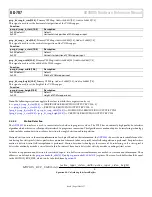
UG-707
ADV8005 Hardware Reference Manual
Table 27: VID Set to PtoI
Input Timing Format to
P2I
576p
1080p50
480p
1080p60
svsp_m_p2i_vid
17
31
2
16
The PVSP PtoI does not have direct access to the data from the input pins but it can be utilized to convert a progressive input format to interlaced
using the PVSP core bypass path by setting the
3.2.3.16.
Automatic Contrast Enhancement
The Automatic Contrast Enhancement (ACE) block is used to intelligently enhance the contrast of the whole picture by making dark regions
darker and bright regions brighter. It is stable under scene changes as well as being robust in the presence of noise. ACE
supports both interlaced and progressive inputs and can be enabled/disabled using
ace_enable
, IO Map,
Address 0x1A30[7]
This bit is used to enable the automatic contrast enhancement (ACE) block.
Function
ace_enable
Description
0 (default)
Bypass A.C.E.
1
Enable A.C.E.
3.3.
SECONDARY VSP
3.3.1.
Introduction to SVSP
Figure 62:
SVSP
shows the structure of the SVSP
.
The SVSP comprises of four sections; the VIM, the VOM, a controller which is the FFS, and a PtoI
converter.
The SVSP can be used to offer the option of a second output resolution to the user. The structure of the SVSP is similar to the PVSP but it is
much simpler in design and does not contain all the processing elements of the PVSP. The structure of the SVSP comprises FFS, VIM, and VOM
blocks.
Input to the SVSP can only be in progressive format.
The SVSP has the following features:
•
Image cropping
•
Scaling
•
FRC
•
PtoI conversion
The image cropping function is the same as that provided in the PVSP and, like the PVSP, there is an image cropper in both the VIM and the
FFS
VIM
VOM
Secondary VSP
Input
Video
Output
Video
Write to
DDR2
Read from
DDR2
Progressive
to Interlaced
FFS
VIM
VOM
Secondary VSP
Input
Video
Output
Video
Write to
DDR2
Read from
DDR2
Progressive
to Interlaced
Rev. A | Page 134 of 317
















































